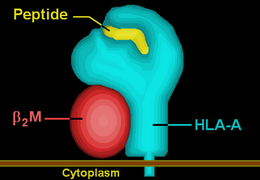HLA-A33
| HLA-A33 | ||||||||||||||||
|---|---|---|---|---|---|---|---|---|---|---|---|---|---|---|---|---|
| (MHC Class I, A cell surface antigen) | ||||||||||||||||

HLA-A33
|
||||||||||||||||
| About | ||||||||||||||||
| Protein | transmembrane receptor/ligand | |||||||||||||||
| Structure | αβ heterodimer | |||||||||||||||
| Subunits | HLA-A*33--, β2-microglobulin | |||||||||||||||
| Subtypes | ||||||||||||||||
|
||||||||||||||||
| Alleles link-out to IMGT/HLA database at EBI | ||||||||||||||||
|
Subtype
|
allele
|
Available structures
|
|---|---|---|
| A33 | *3301 | |
| A33.3 | *3303 | |
| {{{cNick3}}} | *33{{{cAllele3}}} | |
| {{{cNick4}}} | *33{{{cAllele4}}} |
HLA-A33 (A33) is a human leukocyte antigen serotype within HLA-A serotype group. The serotype is determined by the antibody recognition of α33 subset of HLA-A α-chains. For A33, the alpha "A" chain are encoded by the HLA-A*33 allele group and the β-chain are encoded by B2M . A33 and A*33 are almost synonymous in meaning. A33 is a of the serotype A19. A33 is a sister serotype of A29, A30, A31, A32, and A74.
A33 is more common in Subsaharan Africa.
A33 has a poor serotyping rate.
A33 shows two different distributions that can be discriminated by subtyping capability of SSP-PCR.
The first distribution appears to have a Western distribution that introgresses into Europe as a result of the Post-neolithic periods. It is commonly found in linkage disequilibration within the A*3301-Cw*0802-B*1402 haplotype which can be extended to DRB1 and DQB1 in certain instances(See Below). The source of its general expansion appears to be the middle east or the levant, as it is found in the Palestinian population. B14 splits into B64 (B*1401) and B65 (B*1402) but the only Arabian people which show both antigens are the United Arab Emirates.
Certain alleles confound population histories. At the top of that list is A*3303. This allele appears to jump, literally, out of West Africa into South Asia. The point of origin is Africa, most likely central or western Africa given the low levels in East Africa (although much of East Africa is undersampled). In certain tested populations of the Middle East the leve of A*3303 is either very low, or non-existent. Within East Africa Sudan appears to be the highest at around 2%. The frequency of A*3303 begins to rise in eastern Arabia (Oman, UAE) and then markedly rise in the Brahui and Balochi of Pakistan. One haplotype stands out, the A33-B58-DR3-DQ2 haplotype which is found in West Africa, in Sudan, and Pakistan, scattered along West Indias coast, the Turkic republics and appears to have recently introgressed into Korea (post-Yayoi period of Japan) and China. So recent arrival into Asia that the level of HLA DR3-DQ2 in Korea of 2.9%. Korea is the major recent source of Japanese genes, by the Yayoi period that lasted from 3000 to 1600 years ago approximately 3/4ths of Japanese genetic makeup is attributed to this migration. And yet there is trace DR3-DQ2 in Japanese, none in the Ainu nor many other indigeonous Siberian groups.
...
Wikipedia
